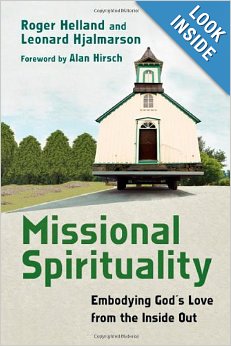Missional Spirituality: Embodying God’s love from the Inside Out by Roger Helland and Leonard Hjalmarson. Downers Grove: InterVarsity Press, 2011. 252pp. Paper. 
With an emphasis on the word “missional,” the book explores aspects of “missional spirituality.” The two authors, having experienced challenges in their own ministries, dare to verify God’s leading in their respective unpredictable communities. By working together, the authors give us a contextually relevant biblical book. There are ten chapters with two appendices.
In the first chapter, Helland and Hjalmarson define “missional spirituality” as a “spirituality that forms and feeds mission.” They both have to readjust to new environments and reflect on their missional spirituality as they shift ministries. They explore spirituality from a biblical perspective. Spirituality is both active and radical, moving from the center to the margins, from temple building to the living Word of God that directs the people to live for Christ. Moreover, it is an attentive and active engagement of the Great Commandment that embodies love for God and neighbor. A missional spirituality, as compared with temple spirituality, is mobile; it expresses its dynamics of loving God from the inside to the outside environment.
In chapter two, the authors deal with the disenchantment that derives from the Enlightenment ethos. Seeds of disenchantment and secularization come from the dualistic approach that separates natural and supernatural, reason and revelation, and, science and faith. Nevertheless, our Heavenly Father is at work in our culture and workplace. As all life is sacred, theological reflection is needed to understand our culture today. Instead of abstract thinking, linear reasoning or analysis, radical obedience to Christ should be the focus of missional spirituallity. A consumeristic culture and “customer service” would focus on one’s needs and wants. Missional spirituality, however, means a paradigm shift on discipleship to engage and act in the marketplace.
In chapter three, four theological foundations provide the framework for the missional spirituality:
1) The Trinity describes a relational family of three divine Persons in one eternal essence. Christian spirituality is relational and Trinitarian;
2) The incarnation is the model for Christians to continue a similar process as they contextualize God’s presence. Missional spirituality should be seen in our daily lives as the church acts as the living temple;
3) The priesthood of all believers is spiritual and missional. Equipping, releasing, and trusting the laity to serve vocationally in the ministry should be the focus of missional spirituality;
4) Shema spirituality reveals substance for life’s training, mission, and spirituality. Devotion to God and love for neighbor characterize missional spirituality.
In chapter four, the authors trace missional spirituality in action. From the early church, classic pietism, the Moravians, the Methodists, and the Christian and Missionary Alliance, the historical survey gives us essential theology and practical examples for missional spirituality in action. Theological reflection through historical studies shows how a deeper spiritual life is influential and applicable to the community at large.
In chapters five through nine, Helland and Hjalmarson deal with issues related to the Great Commandment of Mark 12:38-41. The Great Commandment (chapters five and six) focuses on the practices of heart and soul such as union with Christ, obedience, humility and related topics on missio reading and prayer. Though there is a tendency for the evangelicals to separate spiritual disciplines into the inward and the outward, these practices should be integrated rather than isolated. Chapter seven deals with the issues of the mind, such as the practices of faith, thinking, and gratitude. Chapter eight provides practical suggestions for ways to honor God through our treasures, talents and time while chapter nine presents ways to love our neighbor. A concluding chapter on missional spirituality presents ideas on loving God from inside out. A focus on love inwardly overflows outward through mission. God’s work is central to missional spirituality.
Each chapter ends with two important sections about applying their radical and intentional missional spirituality. The section on “Suggested Primers” allows the reader to review what has been read, and check whether what has been presented is understood. The section on “Discussions Starters” gives practical suggestions for group discussion that can bring their ideas to an applicable level. The two appendices also serve as examples on how missional spirituality can be carried out.
Helland and Hjalmarson challenge their reader to practice faith thinking. For them, faith thinking is the heart of theology. Theological reflection counters the surrounding petty and popular culture. Just as Jesus did in teaching parables, theological imagination gives us visual imagination that is lively and boundless that incites rigorous faith thinking.
The book is to be commended for its originality on the presentation of missional spirituality based on the Great Commandment of Christ that has its roots in the Torah. The strength of the idea is its integrated approach to the concept of spirituality. God is at work in our culture, and we need to exegete the context where we are. Their emphasis on rooting missional spirituality in four theological foundations as its framework is very significant. It gives the biblical foundation for mission and the practical implication for active spirituality. Moreover, historical lessons are drawn for their contribution to the missional spirituality. The historical overview allows the reader to see mission in action. Theology that is based on love for God and neighbor connects spirituality with mission.
The book is not as complete as one might like. One wonders whether other biblical principles could be applied to draw out the same conclusions they make about missional spirituality. For example, a transformed life in Christ flows from a spirituality that comes from the inside out (2 Cor 5:17). With their emphasis on practicing missional spirituality, the authors have argued that believers should exegete their cultures. Although some major trends were interpreted and reflected upon, perhaps they should have given the readers more such examples. Our context today should be interpreted both globally and locally. A “glo-cal” interpretation is needed today as we talk about mission, and especially missional spirituality. Additionally, the authors failed to provide a scriptural index that would be helpful for the reader for further investigation of the biblical texts they used.
This book is recommended for those who are serious about spirituality. Moreover, it can act as a guide for those who would like to practice missional spirituality in their lives.
Review by Joseph Too Shao
BSOP, Karuhatan, Valenzuela City, Metro Manila
